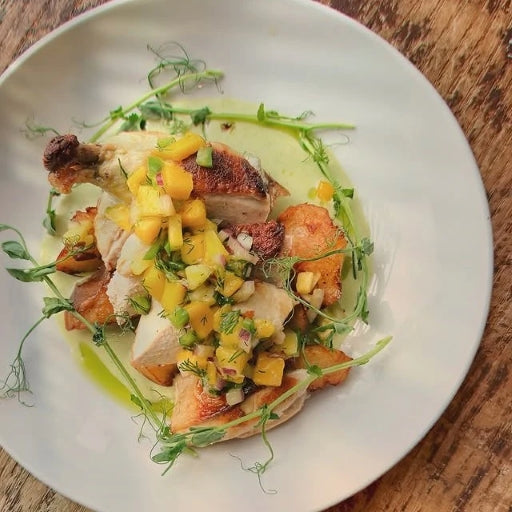
Ever had a salad that was gorgeous but left you feeling… meh? You're not alone. It's a familiar experience: gorgeous leafy greens, vibrant veggies, a drizzle of dressing — and yet, it fails. It's not the taste or the freshness. It's the texture. Or lack thereof.
Texture is the salad bowl's quiet hero. It's what takes a salad from "meh" to oh-so-delicious. Crunch, creaminess, and chew—they're not merely sensory benefits; they're all about enjoyment, digestibility, and satisfaction.
In this post, we're going in-depth on why texture is so important in salads. We'll dive into the sensory science behind it, dissect the most important textures to layer into your bowl, and give you some easy tips to make better salads at home. We'll also demonstrate how we at Planted Detroit construct our texture-filled bowls — because it's not just about being fresh, it's about being intentionally layered.
Why Texture in Food Matters More Than We Think
Our brains are programmed to need contrast. Just as we love sweet and salty combined (hello, chocolate-covered pretzels), we love a mix of textures — crispy and soft, creamy and chewy. The more senses you stimulate, the better it gets.
Research in Food Quality and Preference discovered that texture influences everything from perceived freshness to how much we like a meal. A soft food with no crunch or bite can be unsatisfying, even when it tastes fantastic.
Texture influences:
- Flavor perception (crunch can make freshness feel stronger)
- Satiety (chewing makes us feel full)
- Eating speed (slower eating = better digestion and more awareness)
As far as salad bowls are concerned, texture is probably the most underrated ingredient that can have the largest effect.
The Salad Struggle: Why Some Bowls Disappoint
We’ve all been there: staring down a beautiful bowl of greens only to be met with. meh. The colors might pop, the ingredients might sound fancy, but if the textures are flat, the whole salad falls short. Why? Because texture is what makes a salad feel alive.
When each bite is the same—soft, mushy, or too uniform—you lose interest with your brain and palate. You chew, yet you're unsatisfied. The salad can be fresh, even nutritious, yet it doesn't quite feel like a full, satisfying meal.
This is the downfall of most pre-prepped or hasty homemade salads: too much lettuce, too little mix. The perfect salad bowl is one that will surprise you—crunchy, creamy, chewy, all in one bite. It's stimulating for your senses and leaves you wanting more.
The trick isn't necessarily what you add, but how everything works together—and we're here to teach you how to master that.
The Key Salad Textures and What They Do for You
Let’s take a look at some of the top salad textures, what they feel like, and how the textures affect our neurochemistry!
The Crunch Factor
Crunch is stimulating. It awakens your senses, engages your jaw, and sends satiety signals to the brain. Consider raw vegetables: carrots, cucumbers, bell peppers, snap peas, and shredded cabbage. Or toppings such as seeds, toasted nuts, or croutons.
Crunch doesn't merely make food fun — it really makes you feel full quicker. That physical interaction — the noise, the bite, the resistance — communicates to your body, "Hey, we're eating something serious here."
Creamy & Soft Elements
Too much crunch will send the balance to dryness or exhaustion. Step in creamy textures — the silky, smooth players that add richness and balance. Avocados, goat cheese, hummus, yogurt-based dressings, and soft-boiled eggs all contribute a rich mouthfeel.
These soft elements cover crisper greens, hold ingredients together, and introduce an element of indulgence. If your salad contains both crunch and creaminess, it provides a rhythm to your bite — a little surprise in each forkful.
Chewy & Hearty Additions
Hearty textures such as roasted sweet potatoes, chewy grains (farro, quinoa, and barley), mushrooms, and dried fruits provide salad bowls with the sense of a full meal. They ground the lightness of raw greens and make you feel nourished and grounded.
Chewiness makes you slow down. It provides you with something to work through. And that process — chewing and interacting with your food — makes a tremendous difference in how full you'll feel.

Building Texture-Rich Salad Bowls at Home
When it comes to crafting salad bowls that hit every note, layering with intention is everything. We’re not just tossing ingredients together—we’re composing a multi-textural experience that keeps your taste buds engaged and your body nourished. The key? Starting with a strong base and building upwards with balance in mind.
Start with a delicate, leafy base such as spring mix, arugula, or our go-to—microgreens. Not only are these greens packed with nutrients, but they also add a gentle contrast to denser ingredients. Then, place your creamy components—hummus, soft cheese, or tahini dressing—tucked into the center of the bowl. This way, they won't overpower but rather enhance other textures when you toss.
Your crunchy items—such as cucumber slices, carrots, or toasted seeds—must be atop or along the perimeter, where they will preserve their texture through to the end. Next, your chewy items: roasted sweet potatoes, farro, or dried fruit. They contribute weight and texture, anchoring the salad and making it seem more substantial as a meal.
Every layer should have a purpose. By placing ingredients mindfully, you’re not just improving the texture—you’re elevating the whole experience. Suddenly, your salad isn’t just a side dish. It’s the main event.
Ingredients That Add Instant Texture
You don't require a chef's pantry to create your salad bowls into texturally fascinating meals. A few simple yet strategic ingredients, and you can turn even the plainest greens into a bowl that crunches, melts, and satisfies simultaneously.
Radish rounds provide pungency and crunch in each bite. Roasted chickpeas are protein-dense and contain an irresistible crunch—double points for tossing them with spices such as smoked paprika or cumin. Toasted nuts and seeds are textural giants: sunflower seeds, slivered almonds, or sesame seeds perked things up in an instant.
Craving for creaminess? Test a big spoonful of hummus, a tablespoon of whipped ricotta, or slices of very ripe avocado. These elements provide a deep mouthfeel without drowning the rest of the bowl.
Don't underestimate prep's power. Shredded cabbage is more perceptible than chopped. Roasted broccoli boasts a whole other texture than raw. Even breaking from hard-boiled to soft-boiled eggs can influence how the salad settles.
Need more inspiration? Our Microgreens Collection is a wonderful starting point—they're delicate, light, and complement fuller toppings lovely.
At the end of the day, texturing by layering doesn't have to be difficult. Little adjustments do a world of good, and the right pairing can make your salad genuinely crave-worthy.
How Texture Affects Digestion and Satiety
Texture-based meals automatically slow us down. It's more difficult to gobble down a bowl with varied bite sizes and textures — and that's okay.
Increased chewing provides your body time to send out satiety hormones such as leptin. It also enhances digestion, beginning in the mouth, where saliva starts breaking down starches. The payoff? You take in nutrients more efficiently and remain full longer.
Feeling Full and Nourished
Salads with several different textures don't merely taste more delicious — they feel more satisfying. Working your jaw and senses allows your brain to acknowledge you've consumed something solid, making post-meal snacking less likely.
Well-balanced salad bowls leave you full, nourished, and energized, rather than sluggish and bloated.
What We Prioritize in Our Planted Detroit Salad Bowls
At Planted Detroit, we design salad making with texture in mind first. Freshness is the base, but how ingredients feel is what makes them stick.
We construct our salad bowls with intention:
- Crunch from raw vegetables, toasted seeds, and crisp greens
- Creaminess from house-made dressings, avocado, or cheese
- Hearty chew from roasted vegetables, grains, or plant-based proteins
Every one of our salad bundles is carefully crafted to balance these ingredients. It's not a salad — it's an experience where texture takes the lead in every bite.
We also add microgreens, which not only add nutrition but also add a subtle crunch that makes each bowl stand out. (And yes, we cultivate those in-house.)

Ready to Level Up Your Salad Game?
Here's your next salad challenge: create (or purchase) a bowl with texture in mind. Pay attention to what's crunchy, what's soft, what's chewy — and how each bite makes you feel.
We promise, it makes all the difference.
If you'd rather bypass the guesswork and savor perfectly balanced texture, see how our Planted Detroit Salad Bundles come together. We've done the layering, seasoning, and sourcing for you — all you have to do is dig in.
Because when texture gets the spotlight, salad satisfaction isn't just on the table — it's a done deal.
